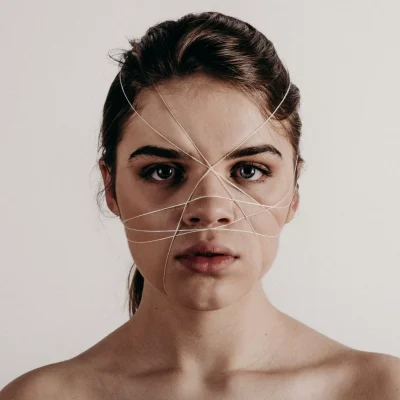Is it true that taping can help reduce puffiness, enhance the jawline, and sculpt the chin? And can this be done at home on your own? Absolutely, as long as it’s done correctly! Let’s explore the art of using tape to diminish that stubborn double chin.
What is Taping?
Taping involves the use of a flexible (often vividly colored) strip, typically crafted from cotton or nylon. These materials were carefully selected because of their texture and elasticity, mimicking the properties of human skin. The technique was pioneered by Japanese cosmetologist Kenzo Kase in the early 1970s and has since become a well-regarded method for restoring youthful vibrancy to the skin—similar to self-massage and face building.
The reverse side of the tape is coated with a specialized acrylic adhesive, which bonds firmly to the skin when it comes in contact with warmth. The primary principle here is adhesion. You can apply the tape to the skin of your face after a massage when the muscles are warm and relaxed, to prolong the effects. In some cases, the mere relaxation of facial muscles is enough to impart a refreshed appearance. Taping after face building—when muscles are more toned—also enhances the procedure’s effectiveness.
What Results Can You Expect from Taping?
In addition to extending the benefits of other facial muscle relaxation or toning techniques, taping can work wonders in reducing swelling and lifting the contours of your face. The most sought-after result of taping is, undoubtedly, a noticeable lift—especially effective in targeting the double chin.
How Long Should You Keep the Tape on Your Face?
One of the main advantages of taping is that it works while you’re occupied with other activities—whether you’re watching a movie, preparing dinner, or even asleep. However, the more relaxed you are during the process, the more effective it will be.
For first-time users, it’s best not to leave the tape on overnight. Experts recommend starting with 30–45 minutes. If your skin feels fine, you can gradually extend the duration, even leaving the tape on for two to three hours or overnight—provided it remains comfortable. No discomfort should occur.
Remember, consistency is key—it’s far more beneficial to wear the tape daily for 30 minutes than to do so once a week for an entire night.
Important Note: Overextending the wear time can lead to increased puffiness, so be mindful of this.
How to Effectively Remove a Double Chin Using Taping
Step-by-Step Guide:
- Prepare Your Skin: Thoroughly cleanse your chin area and dry it completely, as the tape will not adhere properly over makeup.
- Massage (Optional but Recommended): Before applying the tape, you can perform a gentle massage on the area to enhance the results.
- Cut the Tape: You’ll need two strips of tape of standard width. The first should be about 8 cm long, and the second should be cut to match the length between the two corners of your jawline.
- Begin with 30 minutes: Start by leaving the tape on for just 30 minutes, gradually increasing the time as your skin adapts.
- Monitor for Discomfort: If you experience itching or burning sensations, remove the tape immediately.
- Remove Carefully: After the procedure, gently peel off the tape and apply a soothing cream to your skin.
Taping Pattern:
- Apply the shorter 8 cm strip from just below your lower lip, across the chin, and down to your neck. Ensure that it follows a straight path through the center.
- The second strip should be applied along the jawline, overlapping the first strip.
This simple method is an excellent way to start using tape, as it’s nearly foolproof. Still, there’s room for error if the technique isn’t followed precisely.
Visible Results
The results of taping differ from many other cosmetic treatments in that you’ll notice immediate effects. However, since taping is more of a surface-level therapy, the improvements will be temporary. The duration of the effect depends on your skin type—thinner skin tends to show stronger results. As with any process, the cumulative effect is also at play. The more frequently you apply tape, the longer your skin will maintain the relaxed state, resulting in prolonged benefits over time.
Avoiding Common Taping Mistakes
The key to a successful taping session is not to stretch the skin when applying the strips. It must remain relaxed—any tension will nullify the procedure’s effectiveness and potentially cause harm. Stick to the designated areas for application; avoid over-taping your face.
Who Should Avoid Taping?

Although taping is generally safe, it’s not suitable for everyone. The primary condition for using tape is that your skin must be healthy. If you’re experiencing inflammation, irritation, excessive dryness, or open wounds, these must be healed before proceeding with any aesthetic treatments. Healthy skin is the foundation for any cosmetic procedure.
Another potential contraindication is an allergic reaction to acrylic. Before applying the tape to your face, conduct a patch test by placing a small strip on your wrist and leaving it for 30 minutes. If you experience no adverse reactions, you’re good to go.
By following these guidelines and maintaining a consistent routine, you’ll be well on your way to reducing the appearance of a double chin with the help of this fascinating taping technique.






